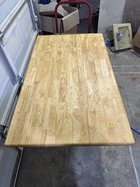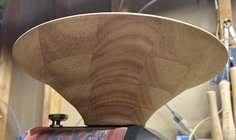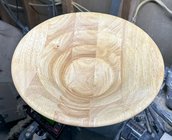wet black birch....love the wintergreen aroma
-
December 2025 Turning Challenge: Single Tree! (click here for details) -
Congratulations to Bob Henrickson, People's Choice in the November 2025 Turning Challenge (click here for details) -
Congratulations to Guillaume Fontaine for "Old Tea Pot" being selected as Turning of the Week for December 15, 2025 (click here for details) -
Welcome new registering member. Your username must be your real First and Last name (for example: John Doe). "Screen names" and "handles" are not allowed and your registration will be deleted if you don't use your real name. Also, do not use all caps nor all lower case.
You are using an out of date browser. It may not display this or other websites correctly.
You should upgrade or use an alternative browser.
You should upgrade or use an alternative browser.
What Wood Smells the Best to You?
- Thread starter Kent Reisdorph
- Start date
I think it smells a bit like loose leaf black tea. Very nice.I know it might sound strange but my favorite wood smell is Ash. I cut down a huge Arizona Ash a couple of years ago and processed the whole thing. My first time taking a tree to turned items. Now, every time I turn Ash it reminds me of that first experience.
Of the species I’ve turned it would be cherry, eastern red cedar, and pecan.
Back when my sniffer worked better I thought fresh milled hickory smelled like chocolate cake mix.,
My favorite wood smell is apple, in my smoker, with ribs.
I found a country table top on Marketplace for $10 and I’ve used it to make several bowls from boards. The woman selling it said it’s old and was her grandparent’s table.



I don’t know what type of wood it is but her grandmother must have sat at this table getting dressed every morning because the table top and everything made from it smells like my grandmothers perfume.



I don’t know what type of wood it is but her grandmother must have sat at this table getting dressed every morning because the table top and everything made from it smells like my grandmothers perfume.
Now THAT'S freaky! The machine finger-jointed boards look somewhat modern, and the wide annual rings of the wood look like a fast-growing species from way South of here. It almost looks like Mango.
The bowl looks great!! Love the shape!
The bowl looks great!! Love the shape!
I've been turning a lot of Lemon lately... It smells like popcorn...
Port Orford Cedar has an indescribable aroma that is pleasant in moderation and nothing like any other.
I like Camphor but it is a bit strong. I think I like Cedar a bit better.
This style of finger jointing is more 'modern'. The wood is most likely rubber tree. They are good for about 20 years and then are cut down. Open pores is typical. They don't waste anything... There are a lot of things out there made from the rubber trees.I found a country table top on Marketplace for $10 and I’ve used it to make several bowls from boards. The woman selling it said it’s old and was her grandparent’s table.
View attachment 61670
View attachment 61671View attachment 61672
I don’t know what type of wood it is but her grandmother must have sat at this table getting dressed every morning because the table top and everything made from it smells like my grandmothers perfume.
robo hippy
Good to know, thank you. I had no idea what type of wood it was. All I knew was that it was fairly hard.This style of finger jointing is more 'modern'. The wood is most likely rubber tree. They are good for about 20 years and then are cut down. Open pores is typical. They don't waste anything... There are a lot of things out there made from the rubber trees.
robo hippy
On a quick search the majority of sites claim a Janka hardness of around 900 for rubber tree, but at least one site claims 1700. It seemed somewhere between those two when sanding it.
Last edited:
- Joined
- Sep 1, 2023
- Messages
- 13
- Likes
- 21
- Location
- Golden Valley, MN
- Website
- www.woodsworthhandmade.com
Padauk 100%
We bought a series of distressed furniture from a guy north of Houston made of similar wood, shipped in from India. I modified some of it and found it the hardness varied a bit, often between two different pieces or where the wood was used on the same piece. Mango is commonly used and a bit harder that Rubberwood, but just looking at the surface they look quite similar and both are found in Asia. From what I understand, the Rubberwood has more distinctive growth rings than the Mango. Both were much harder to bore through with a hole saw than I expected for such an open grain, relatively light wood. Next time you go to IKEA look at their cutting boards and such. It will look quite similar.Good to know, thank you. I had no idea what type of wood it was. All I knew was that it was fairly hard.
On a quick search the majority of sites claim a Janka hardness of around 900 for rubber tree, but at least one site claims 1700. It seemed somewhere between those two when sanding it.
Camphor is my favorite but cedar is also up there.
I couldn't be in the same room with either of those, let alone turn them. I like the smell of cherry, maple, and oak.Camphor is my favorite but cedar is also up there.
Eastern red cedar!Which wood do you like the smell of the most? I'm pretty fond of cherry. I have some sassafras but I haven't used it enough to comment on the spicy smell.
Amboyna burl, a very savory aroma.
Most Definitely Cedar! I think the aroma is very soothing.Which wood do you like the smell of the most? I'm pretty fond of cherry. I have some sassafras but I haven't used it enough to comment on the spicy smell.
I have to Agree Western red ceder Smell the bestMost Definitely Cedar! I think the aroma is very soothing.
Cedar. We have a lot of it here in SW Washington. I'm always fighting the tearout because it's so soft.
Which one? Lots of cedars. Western Red, Incense, Lebanon, Eastern Red, etc.I’m a fan of cedar.
That is European-pattern fingerjoint. You see the fingers from the top. North American pattern the fingers are on the side. And yeah, sure looks like rubberwood to me. Not very old.This style of finger jointing is more 'modern'. The wood is most likely rubber tree. They are good for about 20 years and then are cut down. Open pores is typical. They don't waste anything... There are a lot of things out there made from the rubber trees.
robo hippy
Yes. I also love Spanish cedar (I used to make cigar humidors)..... which is NOT a cedar, but in the mahogany family. I don't care. I love it. Never turned it though.Port Orford Cedar has an indescribable aroma that is pleasant in moderation and nothing like any other.
Oh, that's easy: a whole workshop full of folks going at smooth planing Alaskan Yellow Cedar timbers in one of Dale Brotherton's workshops. Heavenly. I really need to have a go at turning AYC... (or Port Orford, if I can get any..)
I just Googled the above so if you want to get a confusing idea of what cedar really is then try that. The surest thing about it is that eastern red cedar is really juniper but then it would not sound right to have a "juniper chest" rather than a "cedar chest".cedars. Western Red, Incense, Lebanon, Eastern Red
Port Orford Cedar is by far my favorite wood aroma, though I've never turned any. As above not a true cedar. I do like Myrtle (Bay Laurel). It can be a bit overwhelming. Had a Myrtle burl on the lathe and it perfumed the shop for weeks after it was done.
I just did a rough turn on an urn in Black cherry and I think that is the most pleasant smelling wood without being allergenic "at least to me".
Built a table for my daughter from aromatic cedar once. I enjoyed the smell at first, but it was eventually overpowering. I've never turned any wood with a pleasing smell, except green spruce one time, and one time was the only time that will ever happen.
Ailanthus altissima ( Tree of heaven). When the wood was wet it smelled like a foul horse barn. When dried and sanded it had an aroma of freshly baked bread. Since I had only one piece, there was no way to tell if this is common or a fluke.
Ailanthus altissima ( Tree of heaven). When the wood was wet it smelled like a foul horse barn. When dried and sanded it had an aroma of freshly baked bread. Since I had only one piece, there was no way to tell if this is common or a fluke.
The two pieces I turned, I never got beyond foul smelling.
